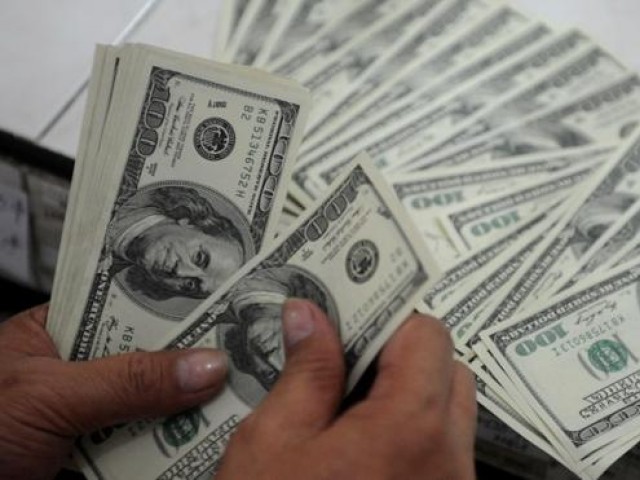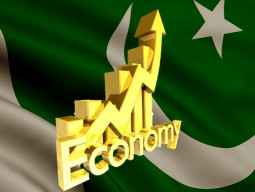
After almost half its term at the helm, Pakistan Muslim League-Nawaz (PML-N) still continues to fend off allegations of election rigging and dismissive remarks over the country’s economic performance. While the government blows the trumpet of increasing foreign exchange reserves, critics tend to be indifferent over the progress as well, terming most of it as plagued with debt and borrowing.
Inflows and outflows of funds on a daily basis make it impossible to ascertain the exact share of borrowed money in foreign exchange reserves.
But a quick look at the timeline and accompanying notes reinforces the popular view that the increase in SBP-held foreign exchange reserves is mostly on the back of money that the government has either raised from global investors or borrowed from international financial institutions.
In addition to total disbursements amounting to $4.5 billion from the IMF since 2013, Pakistan has also raised at least $3.5 billion from the international bond market by floating Sukuks and Eurobonds.
In its many reports on the economy, the SBP has made it abundantly clear that it is not particularly fond of the government’s approach to shore up foreign exchange reserves on borrowed funds.
It should be noted that repayments to the Paris Club -- following the debt rescheduling of December 2001 – are set to begin in 2016-17 whereas IMF repayments will start from 2017-18. It is against this backdrop that the SBP believes shifting financing away to non-debt creating inflows (i.e. foreign investments) is a must to strengthen the country’s debt servicing capacity in the future.
“A sustainable solution requires narrowing the FX gap with real earnings from exports and/or remittances, rationalisation of imports, and curbing smuggling,” the central bank advised the government in one of its recent reports.
 DESIGN: NABEEL AHMED
DESIGN: NABEEL AHMEDJune 2013
Nawaz Sharif-led PML-N promised an economic turnaround. But the external sector was in the doldrums already, with the country having exhausted about one-quarter of its liquid foreign exchange reserves in the past 12 months. That was mainly to pay the external deficit of $2 billion along with International Monetary Fund (IMF) repayments amounting to $2.5 billion.
The result was a massive drop in foreign exchange reserves held by the SBP: from $10.8 billion at the start of 2012-13, they stood at just above $6 billion by the end of the fiscal year.
The dire situation on the external-sector front left PML-N’s economic wizard Ishaq Dar with no choice but to seek help from the IMF – the lender of last resort.
Wooing the IMF made sense: once a country is under the IMF wings, it becomes easier for it to borrow funds from other international financial institutions (IFIs) to shore up its reserves.
Read: Foreign exchange: SBP’s reserves clock in at $15.202b
September 2013
Pakistan entered a three-year IMF loan programme of $6.64 billion in the first quarter of 2013-14. With the Washington-based lender pledging to bail the country out, chances of a balance of payment crisis were now minimal and a default on international payments was definitely out of the question.
But that didn’t mean the situation on the external sector was firmly under control. The IMF programme was “not frontloaded,” meaning Pakistan was going to receive funds from the IMF in equal quarterly tranches provided the country stuck to the reforms agenda set by the IMF.
There were no Coalition Support Fund (CSF) disbursements during the quarter while external debt servicing amounted to a massive $1.8 billion. According to the SBP, there was a net drawdown of $1.3 billion in July-September from SBP reserves, which was three times larger than the decline seen in the same quarter of the preceding fiscal year.
December 2013
Foreign exchange reserves were not that high to begin with and the situation became worse during November because Pakistan had to repay $725 million to the IMF. The SBP-held foreign exchange reserves touched their lowest point ($3 billion) since 2000-01 in the second quarter of 2013-14.
However, slight improvement took place towards the end of the quarter, as the country received the second tranche of $554 million from the IMF. Times ahead seemed promising now that the “lumpy repayments” to the IMF on account of a previous loan under the stand-by agreement were over. Going forward, repayments to the IMF would now be largely offset by disbursements from the IMF.
March 2014
The SBP could now state confidently that the pressure on the country’s foreign exchange reserves had finally “started to ease” post-December 2013, thanks in part to a “lumpy inflow” of $1.5 billion from an Arab country in March.
Pakistan’s foreign exchange reserves increased $1.8 billion in the third quarter of 2013-14 as opposed to a decline of $1.6 billion in the same three-month period of the preceding fiscal year.
June 2014
The three-month period ending on June 30, 2014 witnessed the largest expansion in the SBP-held foreign exchange reserves on a quarter-on-quarter basis in recent years.
Entering the global bond market after seven years, Pakistan sold sovereign bonds to generate $2 billion from international investors in April. Furthermore, the government sold the long-due 3G/4G spectrum licences, giving another boost of $517 million to reserve in the same month.
Pakistan received another $1 billion from the World Bank and $375 million as part of the CSF in May, bringing the total SBP-held reserves to $9.2 billion, up 73% from March 2014.
September 2014
The surge in SBP-held foreign exchange reserves for two consecutive quarters took a breather in the first three-month period of 2014-15.
Although the country received $735 million under the CSF in July-September, the retirement of $1.5 billion of external debt -- coupled with delays in the fourth review of the IMF programme and political uncertainty owing to the sit-in by an opposition political party – resulted in a net decline of 4% in the SBP-held foreign exchange reserves.
Read: Foreign exchange: SBP’s reserves dip below $13.5b
December 2014
The government issued an Islamic bond (Sukuk) in the international market worth $1 billion during the quarter. While a sharp drop in global oil prices was reducing the country’s oil import bill, the resumption of disbursements from the IMF after its fifth review of the loan programme further strengthened the external sector.
March 2015
Although Pakistan received an inflow of $717 million in February under the CSF, a number of budgeted inflows did not materialise in January-March. These include $3 billion from ADB, IDA and China. Therefore, repayments exceeded the total disbursements in the three-month period ending on March.
June 2015
SBP-held foreign exchange reserves surged 17% over the quarter ending on June 30 due in part to the divestment of SBP’s stake in Habib Bank in April.
Reserves went up by almost 4% in the same month following the receipt of $538 million from multilateral, bilateral and other sources, including $498 million received from the IMF.
September 2015
Foreign exchange reserves held by the SBP increased $772 million in July because of the receipt of $756 million from the World Bank.
Despite official inflows of $418 million, including receipts of $337 million under the CSF, SBP-held reserves remained almost flat on a quarter-on-quarter basis.
October 2015
The second quarter of 2015-16 began with a massive inflow into the SBP-held foreign exchange reserves, which rose by $1.8 billion on October 2. The SBP received $505 million from the IMF, $500 million as proceeds of the Pakistan International Bonds, $376 million under the Coalition Support Fund (CSF) and $263 million as syndicate financing for the government of Pakistan.
Published in The Express Tribune, October 14th, 2015.
Like Business on Facebook, follow @TribuneBiz on Twitter to stay informed and join in the conversation.









1732794933-0/Express-Tribune-(1)1732794933-0-270x192.webp)
1732084432-0/Untitled-design-(63)1732084432-0-270x192.webp)






COMMENTS (13)
Comments are moderated and generally will be posted if they are on-topic and not abusive.
For more information, please see our Comments FAQ